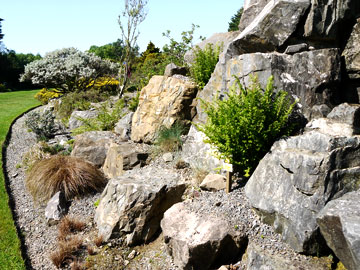Constructing the Rock Garden
Hard Landscaping
You should begin construction with the rocks and concern yourself with soil infill later. After all, apart from the plants, it is rocks that are the main feature in a rock garden.
Lowest Level of Rocks
Begin at path level, whether that is a path that runs through the rockery or an area at the side that provides the best viewpoint. Position the base rocks so as to outline the boundary of the rock garden. Select rocks of varying size and position each with the largest surface facing downward. For a natural appearance, they should be angled slightly so that the outward showing face of each rock is pointing slightly upwards. This usually means that the end of each rock that is furthest away will be partly buried in the ground.
The lowest level of rocks should be close to each other but not butted together side by side. Small gaps of varying widths should be left to be filled with soil.
Once this base layer of rocks is in place and you are happy with the outline boundary of the rock garden, gaps between the rocks should be filled with soil. It is this soil that will keep everything in position and ensure stability so it is important that it is firm. Use a stick or some other instrument to ram the soil into every nook and cranny.
Also backfill any area behind the rocks to provide a firm base for the next layer of rocks. The natural expectation is that this backfilling will consist of soil, though depending upon the amount of space and the eventual height of the rock garden, this might be an ideal place to hide away some garden waste or rubble as long as it is stable and not likely to cause any contamination.
Read Also:
- Siting a Rock Garden
- Materials for a Rock Garden
- Constructing a Rock Garden
- Planting Up a Rock Garden
- Planning a Rock Garden
Second and Subsequent Rock Layers

Construction continues with second and subsequent layers of rocks. The front faces of the rocks should be set back slightly from those of the underlying layer to form a slope from the lowest to the top most layer of rocks.
Just how far back depends upon the amount of slope you want in the finished garden and this will be determined by surrounding features of the garden and your own personal preference. It is vital, however, that the finished structure is completely stable with no possibility of rocks coming loose and falling out. As each layer of rocks is added, more soil is rammed home to ensure they are fixed in place.
Infill with Soil
Bear in mind that the eventual idea is to incorporate plants into the garden and so you should incorporate gaps of sufficient size for the plants you have in mind. The pockets of soil should not be uniform but should vary in size, shape, and distribution, with sufficient depth of soil for the types of plants you intend to grow.
Although you can incorporate poor quality soil and even rubble behind the rocks, the soil where you intend to plant should be a good quality loam (see Soil Types) Some small stones may help with drainage, along with some general purpose fertilizer. However, it is worth reading up on the preferred growing conditions of your chosen plants before deciding exactly what additional ingredients to incorporate.
You can continue building the layers to whatever height you please as long as it doesn't cause instability. Also bear in mind that the rocks effectively form a barrier or wall to contain the soil that you use for back filling and therefore they need to be sufficiently stable and robust so as not to collapse under the weight and pressure of the soil.
Read Also:
- Siting a Rock Garden
- Materials for a Rock Garden
- Constructing a Rock Garden
- Planting Up a Rock Garden
- Planning a Rock Garden
